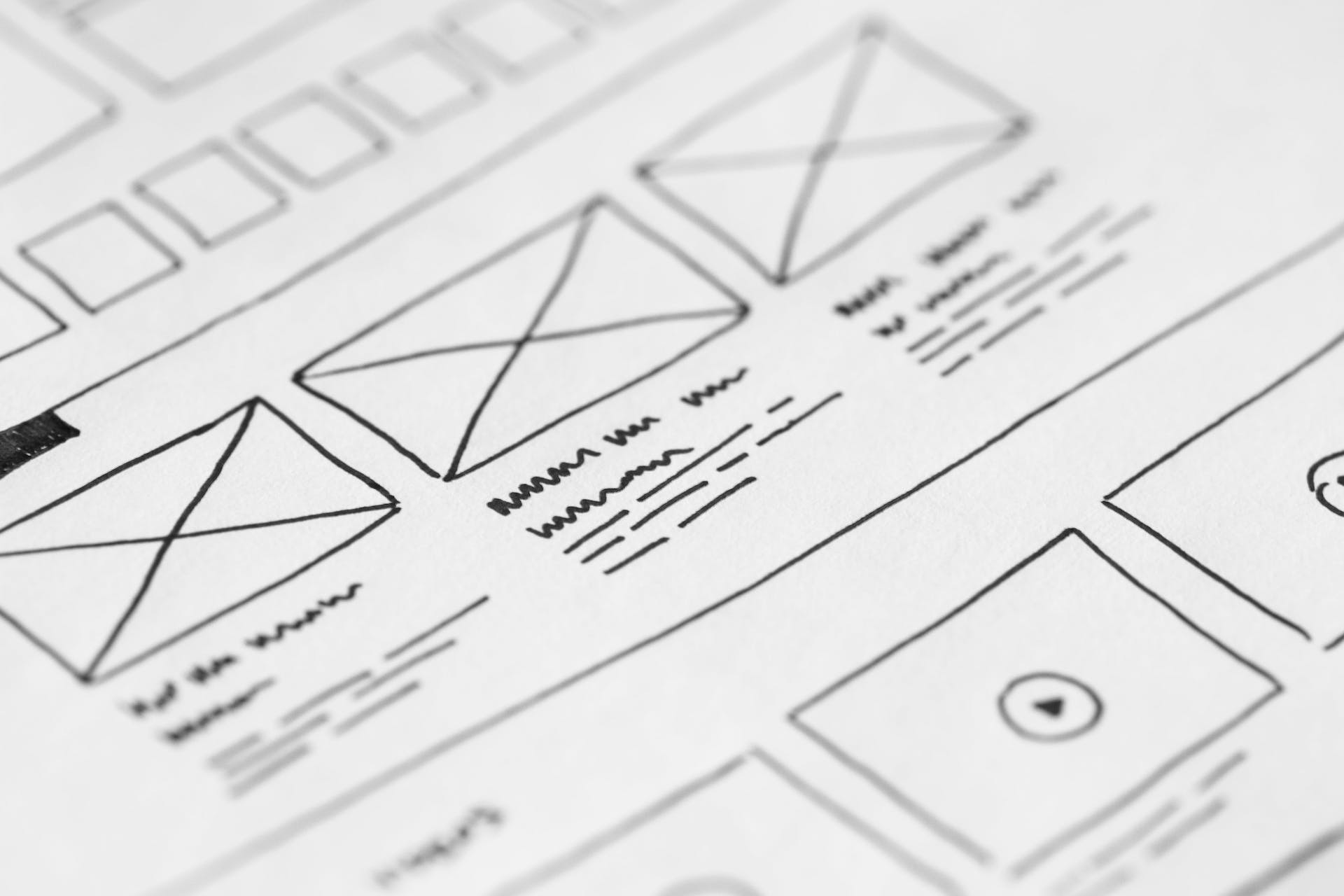
The Language of Modern Design: Enhancing Communication Through Visuals
In the digital age, design is crucial for effective communication between businesses and their audience. Whether through websites, applications, or marketing materials, design serves as the bridge between businesses and their audience.
In this exploration, we delve into various facets of the language of modern design, from minimalism to modern strategies, elucidating how your business can stand out in your niche or market.
Minimal Design: Less is More – The Language of Modern Design
How minimal design conveys any message better than clutter or overly crowded layouts.
Minimalism in design is not merely about aesthetics; it’s a philosophy that emphasizes simplicity and clarity in communication. By stripping away unnecessary elements, minimal design allows the core message to shine through without distractions. Here’s why it’s effective:
- Clarity: Minimalist designs present information in a clear and concise manner, ensuring that the audience can quickly grasp the intended message.
- Focus: By eliminating clutter, minimal design directs the viewer’s attention to the most important elements, such as calls-to-action or key information.
- Memorability: Simplified designs are easier to remember, as they leave a stronger impression on the viewer’s mind.
- Accessibility: Minimalist interfaces are often more accessible, catering to a wider range of users, including those with disabilities.
In a world inundated with stimuli, minimal design cuts through the noise, delivering messages with precision and impact.
Importance of Breathing Room and Colors in Design
In the language of design, white space—or negative space—is just as important as the elements themselves. Here’s why breathing room matters:
- Visual Hierarchy: White space helps establish visual hierarchy by creating separation between different elements. This allows users to prioritize information and navigate the layout more easily.
- Readability: Adequate white space prevents visual clutter, ensuring that the content remains clear and legible. It gives the eyes a rest, making it easier for users to absorb information without feeling overwhelmed.
- Formatting: White space directs attention to key elements, such as calls-to-action or important messages, increasing their visibility and effectiveness.
- Aesthetics: White space contributes to the overall aesthetics of a design, creating a sense of balance, elegance, and sophistication.
DesignDiverso understands the importance of white space in effective communication and employs it strategically to enhance the user experience and achieve desired outcomes.
The Vital Role Played by Colors
Colors are more than just a way to recognize your brand; they are powerful tools for communication and interaction across various touchpoints. Here’s why colors matter:
- Brand Identity: Colors play a crucial role in brand identity, evoking emotions, conveying personality, and distinguishing your brand from competitors. Consistent use of colors strengthens brand recognition and fosters brand loyalty.
- Psychological Impact: Different colors elicit different emotional responses and associations. By understanding color psychology, businesses can leverage colors to influence perceptions, behaviors, and purchasing decisions.
- Accessibility: Color contrast and accessibility are essential considerations in design, ensuring that content is perceivable and usable by all users, including those with visual impairments. DesignDiverso prioritizes inclusive design practices to ensure that colors are used responsibly and inclusively across all touchpoints.
Modern UI Elements and the Pitfalls of Excessive Animation
In today’s digital landscape, UI elements serve as the building blocks of user interaction and engagement. Here’s why modern UI elements are essential:
- Consistency: Modern UI elements help establish consistency across different platforms and devices, creating a cohesive and familiar user experience. Consistent design fosters trust and confidence in the brand.
- Relevance: UI elements should align with the brand message and values, reflecting its identity and personality. DesignDiverso collaborates closely with clients to ensure that UI elements resonate with their target audience and communicate the intended message effectively.
- Usability: Modern UI elements prioritize usability and accessibility, making it easier for users to navigate and interact with the interface. Intuitive design reduces friction and enhances user satisfaction, leading to higher conversion rates and retention.
The double edge sword of animation based websites
While animations and moving elements can add visual interest and dynamism to a website or app, excessive use can have detrimental effects on usability and performance. Here’s why:
- Distraction: Too many animations and moving elements can overwhelm users and distract them from the main content or task at hand. DesignDiverso advocates for judicious use of animations, focusing on enhancing user experience rather than detracting from it.
- Performance Issues: Animations consume system resources and can slow down the loading time and responsiveness of a website or app. This can lead to frustration and abandonment, particularly among users with slower devices or connections.
- Accessibility Concerns: Animated elements may pose accessibility challenges for users with certain disabilities, such as motion sensitivity or cognitive impairments. DesignDiverso adheres to accessibility guidelines and ensures that animations enhance rather than hinder accessibility.
By striking the right balance between modern UI elements and restrained animation, DesignDiverso creates engaging and efficient digital experiences that resonate with users and drive results.
In summary, the language of design encompasses various elements, from white space and colors to UI elements and animations. DesignDiverso leverages these elements strategically to communicate messages effectively, enhance user experiences, and achieve business objectives.
Through thoughtful design and meticulous attention to detail, DesignDiverso empowers SMBs to differentiate themselves in the digital landscape and succeed in a competitive market.
Designing Websites Backed by State-of-the-Art UX Design
How can we help design websites that are backed by state-of-the-art UX Design and money-back guaranteed for ROI?
At DesignDiverso, we prioritize user experience (UX) design to create websites that not only look visually stunning but also function seamlessly.
Here’s how we ensure ROI through our design services:
- User-Centric Approach: We begin by understanding your target audience and their needs, crafting user personas and user journeys to inform our design decisions.
- Intuitive Navigation: Our websites feature intuitive navigation structures that guide users effortlessly through the content, reducing bounce rates and increasing engagement.
- Responsive Design: With the proliferation of mobile devices, we prioritize responsive design to ensure a consistent and optimized experience across all screen sizes.
- A/B Testing: We continuously refine our designs through A/B testing, analyzing user behavior and feedback to iterate and improve conversion rates.
- Money-Back Guarantee: We are confident in the ROI of our end to end design services, which is why we offer a money-back guarantee if our designs fail to deliver the expected results.
DesignDiverso goes beyond aesthetics to deliver tangible results, leveraging state-of-the-art UX design principles to drive business success.
Modern Minimal Design vs. Obsolete UI Approaches
The shift towards modern minimal design represents a departure from outdated UI approaches characterized by cluttered layouts and outdated aesthetics. Here are the key differences:
- Simplicity: Modern minimal design embraces simplicity, focusing on essential elements and clean aesthetics, while obsolete UI approaches tend to cram too much information onto the screen, leading to confusion and overwhelm.
- User Experience: Minimalist designs prioritize user experience, with intuitive navigation and clear hierarchy, enhancing usability and engagement. In contrast, outdated UIs often neglect UX principles, resulting in frustration and high bounce rates.
- Adaptability: Modern technologies allow for responsive design, ensuring that websites and applications adapt seamlessly to various devices and screen sizes. Obsolete approaches may lack responsiveness, alienating mobile users and hindering accessibility.
- Performance: Minimalist designs tend to be more lightweight and optimized for performance, leading to faster load times and smoother interactions. Obsolete UIs, on the other hand, may suffer from sluggishness and technical issues, driving users away.
By embracing modern design principles and leveraging cutting-edge technologies, DesignDiverso ensures that your digital presence remains relevant, engaging, and impactful.

SEO and the Importance of Tailored Infrastructure
In the realm of digital marketing, search engine optimization (SEO) plays a crucial role in driving organic traffic to your website. However, the choice of infrastructure and hosting platform can significantly impact your SEO efforts:
- Tailored Infrastructure: Designing a website or application with SEO in mind requires a tailored infrastructure that allows for customization and optimization. Generic website builders like Webflow, Squarespace or Wix may offer convenience but lack the flexibility and control needed to implement advanced SEO strategies.
- Scalability: As your business grows, scalability becomes paramount. A tailored infrastructure ensures that your website or app can scale up seamlessly to accommodate increased traffic and evolving business needs, whereas rigid platforms may struggle to keep pace.
- SEO Performance: Modern SEO best practices require fine-tuning at both the technical and content levels. With a tailored infrastructure, you have full control over metadata, site structure, page speed, and other factors that impact SEO performance. Generic website builders may impose limitations or restrictions that hinder your ability to optimize for search engines.
DesignDiverso offers bespoke design solutions tailored to your SEO objectives, ensuring that your digital presence ranks high in search engine results and drives organic traffic to your business.
Limitations of Generic Website Builders
While platforms like Webflow, Squarespace, and Wix offer convenience and simplicity, they come with inherent limitations that can hinder your design and SEO efforts:
- Limited Customization: Generic website builders impose design templates and limitations on customization, restricting your ability to create a unique and branded experience for your audience.
- SEO Constraints: While some website builders offer basic SEO features, they often lack the advanced capabilities needed to implement comprehensive SEO strategies, such as custom metadata, schema markup, or server-side optimizations.
- Performance Issues: Websites built on generic platforms may suffer from performance issues, such as slow loading times or poor mobile responsiveness, which can negatively impact user experience and SEO rankings.
- Dependency: By relying on a third-party platform, you become dependent on their infrastructure and policies, risking potential disruptions or limitations to your website’s functionality and SEO performance.
DesignDiverso overcomes these limitations by providing bespoke design solutions tailored to your business objectives and SEO goals, ensuring optimal performance and maximum impact.

Long-Term Value vs. Short-Term Playground: Making Informed Choices for Your SMB
In the realm of website creation and hosting, platforms like Webflow, Squarespace, and Wix offer apparent convenience and simplicity.
Their millionire advertising campaign efforts sure play a role in their recent growth.
It is obvious that their business model is not clear to many of their users.
The decision to opt for these platforms should not be made lightly, as it involves weighing the trade-offs between short-term ease of use and long-term scalability and value. Let’s delve deeper into this critical decision-making process:
Short-Term Apparent Convenience: The Appeal of Webflow, Squarespace, and Wix
Platforms like Webflow, Squarespace, Wix etc… present themselves as quick and easy solutions for building websites, appealing to SMBs looking to establish an online presence without the need for technical expertise. Here’s why they may seem attractive in the short term:
- User-Friendly Interface: These platforms boast intuitive drag-and-drop interfaces and pre-designed templates, allowing users to create websites quickly and without coding knowledge.
- Low Barrier to Entry: SMBs with limited resources can get started with minimal upfront investment, as these platforms offer affordable subscription plans and even free options.
- Rapid Prototyping: For businesses looking to test ideas or create prototypes, Webflow, Squarespace, and Wix provide a convenient playground for experimentation without the commitment of a custom-built solution.
Long-Term Value: The Cons of Short-Term Solutions
While Webflow, Squarespace, and Wix offer apparent short-term convenience, they fall short in meeting the long-term needs and goals of growing SMBs. Here’s why:
- Limited Flexibility: The templated nature of these platforms imposes limitations on customization and scalability. As businesses evolve and expand, they may outgrow the constraints of pre-built templates and require more flexibility and control over their website’s design and functionality.
- Restricted Features: While Webflow, Squarespace, and Wix offer a range of features and plugins, they cannot match the breadth and depth of functionality available with custom-built solutions. Businesses with unique requirements may find themselves limited by the platform’s capabilities.
- Vendor Lock-In: By entrusting their online presence to a third-party platform, businesses risk vendor lock-in, making it difficult to migrate to a different hosting provider or platform in the future. This lack of flexibility can hinder growth and limit strategic options.
Making an Informed Choice: Evaluating Scope and Goals
Before jumping on the trend bandwagon or opting for the seemingly cheapest option, SMBs must carefully evaluate the scope and goals of their project. Consider the following factors:
- Scalability: Assess whether the chosen platform can accommodate future growth and scalability requirements. Will it support increased traffic, expanded features, and evolving business needs?
- Customization: Determine the level of customization and control needed for your website. Does the platform offer the flexibility to tailor the design and functionality to match your brand identity and user experience goals?
- Total Cost of Ownership: Consider the long-term costs associated with platform subscriptions, add-ons, and potential migration expenses. While Webflow, Squarespace, and Wix may offer low initial costs, the total cost of ownership over time may outweigh the benefits.
- Technical Support: Evaluate the availability and quality of technical support provided by the platform. Will you have access to responsive customer support and resources to troubleshoot issues and optimize your website’s performance?
The DesignDiverso Advantage: Tailored Solutions for SMBs
DesignDiverso understands the importance of balancing short-term convenience with long-term value for SMBs. Our tailored design solutions offer the best of both worlds:
- Flexibility: We provide custom-built websites that are tailored to your unique requirements and scalable to support your business’s growth trajectory.
- Feature-Rich Solutions: Our expertise in web development allows us to implement advanced features and functionalities that go beyond the capabilities of generic platforms.
- Freedom from Vendor Lock-In: With DesignDiverso, you retain full ownership and control of your website, eliminating the risk of vendor lock-in and enabling seamless migration to other hosting providers or platforms if needed.
Choosing the Right Path for Your SMB – The Language of Modern Design
The decision to choose between short-term convenience and long-term value is a critical one for SMBs.
While platforms like Webflow, Squarespace, and Wix offer initial ease of use and apparent affordability, they may not provide the flexibility, scalability, and control needed to support business growth and success in the long run.
By partnering with DesignDiverso, SMBs can access tailored solutions that prioritize their unique needs and goals, ensuring a solid foundation for sustained growth and prosperity. All starting at an affordable rate covered by a ROI money back gurantee across our plans.

SEO Limitations of Webflow, Squarespace, Wix, etc…
While platforms like Webflow, Squarespace, and Wix offer convenience and simplicity, they come with inherent limitations that can hinder SEO efforts. Here’s a closer look at the SEO challenges associated with these platforms:
- Limited Customization: Webflow, Squarespace, and Wix provide templates and drag-and-drop interfaces that limit customization options. This can restrict the ability to optimize on-page elements such as metadata, URL structures, and heading tags, which are crucial for SEO.
- Restricted Access to Code: These platforms often restrict access to the underlying code, making it challenging to implement advanced SEO techniques such as schema markup, canonical tags, and custom redirects. Without full control over the code, businesses may miss out on opportunities to improve search engine visibility and rankings.
- Performance Issues: Websites built on generic platforms may suffer from performance issues such as slow loading times and poor mobile responsiveness. Google considers page speed and mobile-friendliness as ranking factors, so subpar performance can negatively impact SEO performance and user experience.
- Inflexible Hosting Infrastructure: Webflow, Squarespace, and Wix offer hosting as part of their packages, but the hosting infrastructure may not be optimized for SEO. Limited server-side configurations and lack of scalability can hinder website performance and indexing by search engines.
- Lack of Flexibility for Off-Page SEO: Off-page SEO activities such as link building and social media integration require flexibility and control over the website’s structure and content. With limited customization options, businesses may struggle to implement effective off-page SEO strategies on these platforms.
Why SMBs Should Opt for Comprehensive Tailored Solutions
Even SMBs with seemingly standard requirements, such as a simple landing page and a request for quotation (RFQ) form, should opt for a more comprehensive tailored solution that includes scalable infrastructure and software. Here’s why:
- Customization for Brand Differentiation: A tailored solution allows SMBs to create a unique and memorable online presence that reflects their brand identity and values. Customized design and functionality help businesses stand out from competitors and attract and retain customers.
- Scalability for Future Growth: While a basic landing page and RFQ form may suffice initially, SMBs should plan for future growth and expansion. A tailored solution provides the flexibility and scalability needed to accommodate evolving business needs, whether it’s adding new features, scaling up infrastructure, or expanding into new markets.
- Optimized Performance and SEO: Comprehensive tailored solutions optimize performance and SEO from the ground up. By leveraging scalable infrastructure, advanced coding techniques, and SEO best practices, businesses can maximize their online visibility, attract organic traffic, and drive conversions.
- Integration with Marketing Efforts: A tailored solution integrates seamlessly with other marketing efforts, such as email campaigns, social media, and content marketing. By centralizing data and streamlining workflows, businesses can improve efficiency and effectiveness across their marketing channels, ultimately driving ROI.
Glorified Hosting Guised as Website Providers
Platforms like Webflow, Squarespace, and Wix operate under a business model that hinges on providing glorified hosting guised as website providers. Here’s why their model may fall short for SMBs:
- Limited Control and Flexibility: These platforms prioritize ease of use and simplicity over customization and control. While they offer convenience for beginners, they lack the flexibility and scalability needed to support long-term growth and success.
- Dependency on Third-Party Infrastructure: SMBs entrust their online presence to these platforms, which control the hosting infrastructure and software environment. This dependency can result in vendor lock-in and limit strategic options for businesses.
- Lack of ROI Guarantee: Webflow, Squarespace, and Wix focus on providing hosting services rather than delivering measurable ROI for businesses. Without a focus on results-driven design and marketing, SMBs may struggle to justify the investment in these platforms.
Investing in Long-Term Success – The Language of Modern Design
SMBs must prioritize long-term success by opting for comprehensive tailored solutions that prioritize customization, scalability, and performance.
While platforms like Webflow, Squarespace, and Wix offer apprent short-term convenience, they fall short in meeting the complex needs of growing businesses.
By investing in a tailored solution, SMBs can ensure they make the most of their combined web design and marketing efforts, with a guaranteed ROI and a solid foundation for sustained growth and prosperity.
The Impact on Brand Equity
Beyond design aesthetics and SEO rankings, the choice of design services has profound implications for brand equity and perception:
- Brand Consistency: A cohesive and well-designed brand experience instills trust and credibility in your audience, reinforcing brand equity and fostering long-term relationships.
- Perceived Value: High-quality design signals professionalism and attention to detail, enhancing the perceived value of your products or services and justifying premium pricing.
- Competitive Advantage: In a crowded marketplace, distinctive design sets your brand apart from competitors, giving you a competitive edge and attracting discerning customers who appreciate quality.
- Customer Loyalty: Positive brand experiences created through thoughtful design lead to higher customer satisfaction and loyalty, driving repeat business and advocacy.
DesignDiverso recognizes the integral role of design in shaping brand equity and offers design solutions that elevate your brand and drive tangible business results.
The Cost of Bad Design
While investing in professional design services may seem daunting, the cost of bad design can far outweigh the initial investment:
- Missed Opportunities: Poorly designed websites or marketing materials fail to capture the attention of your audience, resulting in lost opportunities for engagement, conversion, and revenue.
- Reputation Damage: Subpar design reflects poorly on your brand image, undermining trust and credibility in the eyes of your audience and damaging your reputation in the long run.
- Hidden Costs: Fixing design mistakes or redesigning outdated assets incurs additional costs and resources, exacerbating the financial burden of bad design over time.
- Lost Customers: In today’s competitive landscape, users have little patience for subpar experiences. Bad design drives potential customers away, reducing your market share and hindering business growth.
DesignDiverso offers cost-effective design solutions that deliver measurable ROI, mitigating the risks and costs associated with bad design while maximizing the potential for success.
Affordable Design Solutions with Guaranteed Results
DesignDiverso is committed to providing affordable design solutions without compromising on quality or results. Here’s what sets us apart:
- Transparent Pricing: Our plans are priced competitively, with no hidden fees or surprises. We believe in transparency and clarity, allowing you to budget effectively and make informed decisions.
- Money-Back Guarantee: We stand behind our work and offer a money-back guarantee if our designs fail to meet your expectations or deliver the promised ROI. Your satisfaction is our top priority.
- Flexibility: With DesignDiverso, you have the flexibility to pause, cancel, or modify your subscription at any time, ensuring that our services align with your evolving needs and priorities.
- Proven Track Record: Our team of experienced designers has a proven track record of delivering results for clients across industries. From startups to established brands, we have the expertise and creativity to bring your vision to life.
Don’t let budget constraints hold you back from achieving your design goals. With DesignDiverso, affordable design solutions are within reach, backed by a ROI money back guarantee and a commitment to your success.
In conclusion, the language of design transcends mere visuals; it’s a powerful tool for communication, brand differentiation, and business success.
DesignDiverso offers a unique blend of modern design strategies, UX expertise, and ROI-driven end solutions, empowering SMBs to stand out in a crowded marketplace and drive meaningful results.
Get in touch today, we will be thrilled to offer you a completely free non string attached consultation, and share how DesignDiverso affordable design solutions can elevate your brand and take your business to the next level.


